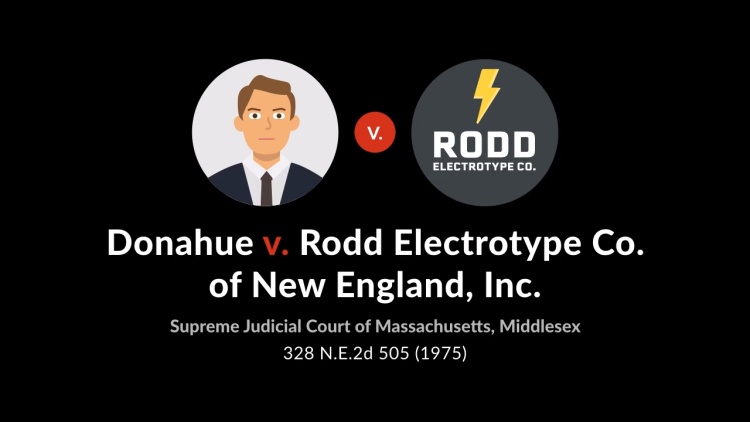Donahue v. Rodd Electrotype Co.
Massachusetts Supreme Judicial Court
328 N.E.2d 505 (1975)
- Written by John Caddell, JD
Facts
Harry Rodd (defendant) served for many years as the president and general manager of Rodd Electrotype Co. In 1955, Harry held 200 of Rodd Electrotype Co.’s 250 shares, representing an 80 percent stake in the company. Joseph Donahue owned the remaining 50 shares, which passed on his death to his wife, Euphemia Donahue (plaintiff), and his son. By the end of the 1960s, Harry had ceded the management of the corporation to his sons Charles and Frederick Rodd (defendants), and Harry wished to dispose of his shares. He gave most of them to his children as gifts. Additionally, Charles and Frederick—who controlled the board—caused the corporation to purchase 45 of Harry’s shares for $800 per share. When the Donahues learned of the purchase, they offered to sell their shares to the corporation on the same terms given to Harry. The board rejected the offer. Euphemia sued Harry, Charles, and Frederick Rodd, as well as the third member of the board, for breaching fiduciary duties owed to her as a minority shareholder. She asked the court to rescind the corporation’s purchase of Harry’s stock. The trial court found in favor of the defendants, holding that the transaction was inherently fair. The appellate court affirmed. Euphemia appealed.
Rule of Law
Issue
Holding and Reasoning (Tauro, C.J.)
Concurrence (Wilkins, J.)
What to do next…
Here's why 899,000 law students have relied on our case briefs:
- Written by law professors and practitioners, not other law students. 47,000 briefs, keyed to 994 casebooks. Top-notch customer support.
- The right amount of information, includes the facts, issues, rule of law, holding and reasoning, and any concurrences and dissents.
- Access in your classes, works on your mobile and tablet. Massive library of related video lessons and high quality multiple-choice questions.
- Easy to use, uniform format for every case brief. Written in plain English, not in legalese. Our briefs summarize and simplify; they don’t just repeat the court’s language.





